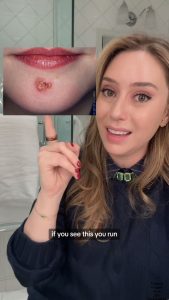In the pursuit of perfect skin, we’ve all been bothered by those pesky pimples around our mouth area. Whether it’s the temptation to cover them with makeup or the accidental touch of a finger, these blemishes can be quite distracting.
But before you give in to the temptation of squeezing a pimple, a TikTok video has raised a concerning question – can you actually get impetigo from doing so?
This post contains graphic images that may be disturbing to viewers. Viewer discretion is advised.
What is impetigo, and what does it look like?
Impetigo is a common and highly contagious skin infection known for causing sores and blisters. While it’s usually not serious, it can be a bit harder to spot in people with darker skin tones.

Photo credit: Vinmec International Hospital
It usually appears as reddish sores on the face, especially around the nose and mouth, and on the hands and feet.
Can popping a pimple cause impetigo?
So, can you really get impetigo from popping a pimple? Shereene Idriss (@shereeneidriss), a certified dermatologist, offers her insights.
The answer? Yes, popping a pimple can lead to impetigo.
But how does this happen? Dr. Idriss points out the “danger triangle on the face,” also known as the “triangle of death” or medically termed the “nasolabial triangle.”

This sensitive area extends from the bridge of your nose to the corners of your mouth.
She explains, “If you have a pimple in this area and your fingers aren’t perfectly clean because, let’s be honest, we don’t wash our hands every second, popping the pimple can spread the infection.”
Bacteria commonly inhabit our nasal passages, and irrespective of our cleanliness, touching our face, particularly this region, can result in the transmission of these microorganisms.
The severity of impetigo-affected areas
At the surface, it’ll resemble the photo below.

When the infection penetrates deeper into the soft tissue, it’s termed furunculosis. Dr. Idriss strongly advises caution, labeling this condition as highly contagious.

How should impetigo be treated as advised by a dermatologist?
When it comes to treating impetigo, Dr. Idriss points out that many of us have staphylococcus in our noses, so the chances of it recurring are relatively high.
However, she stresses the importance of seeing a doctor as soon as you notice the early signs.
Some people can be resistant to treatment with antibiotics and might even have MRSA (methicillin-resistant staph), which can make things more complicated. It’s essential to get a culture test to figure out the type of bacteria you’re dealing with and how to treat it properly.
So, the moral of the story is this: the next time you’re tempted to pop that pimple, think again. Dr. Idriss advises taking a hot shower to help it mature naturally and cover it with a hydrocolloid patch.
The risks are real, so showing restraint might be your best bet.
Featured image credit: @shereeneidriss/TikTok

